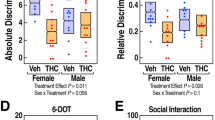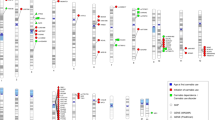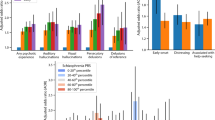Abstract
The adverse effects of cannabis use on executive functions are still controversial, fostering the need for novel biomarkers able to unveil individual differences in the cognitive impact of cannabis consumption. Two common genetic polymorphisms have been linked to the neuroadaptive impact of Δ9-tetrahydrocannabinol (THC) exposure and to executive functions in animals: the catechol-O-methyltransferase (COMT) gene val158met polymorphism and the SLC6A4 gene 5-HTTLPR polymorphism. We aimed to test if these polymorphisms moderate the harmful effects of cannabis use on executive function in young cannabis users. We recruited 144 participants: 86 cannabis users and 58 non-drug user controls. Both groups were genotyped and matched for genetic makeup, sex, age, education, and IQ. We used a computerized neuropsychological battery to assess different aspects of executive functions: sustained attention (CANTAB Rapid Visual Information Processing Test, RVIP), working memory (N-back), monitoring/shifting (CANTAB ID/ED set shifting), planning (CANTAB Stockings of Cambridge, SOC), and decision-making (Iowa Gambling Task, IGT). We used general linear model-based analyses to test performance differences between cannabis users and controls as a function of genotypes. We found that: (i) daily cannabis use is not associated with executive function deficits; and (ii) COMT val158met and 5-HTTLPR polymorphisms moderate the link between cannabis use and executive performance. Cannabis users carrying the COMT val/val genotype exhibited lower accuracy of sustained attention, associated with a more strict response bias, than val/val non-users. Cannabis users carrying the COMT val allele also committed more monitoring/shifting errors than cannabis users carrying the met/met genotype. Finally, cannabis users carrying the 5-HTTLPR s/s genotype had worse IGT performance than s/s non-users. COMT and SLC6A4 genes moderate the impact of cannabis use on executive functions.
Similar content being viewed by others
Log in or create a free account to read this content
Gain free access to this article, as well as selected content from this journal and more on nature.com
or
References
Arnone D, Barrick TR, Chengappa S, Mackay CE, Clark CA, Abou-Saleh MT (2008). Corpus callosum damage in heavy marijuana use: preliminary evidence from diffusion tensor tractography and tract-based spatial statistics. NeuroImage 41: 1067–1074.
Barnes JJ, Dean AJ, Nandam LS, O’Connell RG, Bellgrove MA (2011). The molecular genetics of executive function: role of monoamine system genes. Biol Psychiatry 69: e127–e143.
Barnes SA, Young JW, Neill JC (2012). D1 receptor activation improves vigilance in rats as measured by the 5-choice continuous performance test. Psychopharmacology (Berl) 220: 129–141.
Batalla A, Soriano-Mas C, López-Solà M, Torrens M, Crippa JA, Bhattacharyya S et al (2012). Modulation of brain structure by catechol-O-methyltransferase Val(158) Met polymorphism in chronic cannabis users. Addict Biol advance online publication on 14 January 2013. doi:10.1111/adb.12027.
Bechara A, Damasio H, Tranel D, Damasio AR (2005). The Iowa Gambling Task and the somatic marker hypothesis: some questions and answers. Trends Cogn Sci 9: 159–162.
Bechara A, Tranel D, Damasio H (2000). Characterization of the decision-making deficit of patients with ventromedial prefrontal cortex lesions. Brain 123: 2189–2202.
Behan AT, Hryniewiecka M, O'Tuathaigh CM, Kinsella A, Cannon M, Karayiorgou M et al (2012). Chronic adolescent exposure to delta-9-tetrahydrocannabinol in COMT mutant mice: impact on indices of dopaminergic, endocannabinoid and GABAergic pathways. Neuropsychopharmacology 37: 1773–1783.
Besson M, Belin D, McNamara R, Theobald DE, Castel A, Beckett VL et al (2010). Dissociable control of impulsivity in rats by dopamine d2/3 receptors in the core and shell subregions of the nucleus accumbens. Neuropsychopharmacology 35: 560–569.
Bevilacqua L, Goldman D (2011). Genetics of emotion. Trends Cogn Sci 15: 401–408.
Bilder RM, Volavka J, Lachman HM, Grace AA (2004). The catechol-O-methyltransferase polymorphism: relations to the tonic-phasic dopamine hypothesis and neuropsychiatric phenotypes. Neuropsychopharmacology 29: 1943–1961.
Bolla KI, Brown K, Eldreth D, Tate K, Cadet JL (2002). Dose-related neurocognitive effects of marijuana use. Neurology 59: 1337–1343.
Camí J, Farré M (2003). Drug addiction. N Engl J Med 349: 975–986.
Chamberlain SR, Robbins TW, Winder-Rhodes S, Muller U, Sahakian BJ, Blackwell AD et al (2011). Translational approaches to frontostriatal dysfunction in attention-deficit/hyperactivity disorder using a computerized neuropsychological battery. Biol Psychiatry 69: 1192–1203.
Cuyas E, Verdejo-Garcia A, Fagundo AB, Khymenets O, Rodriguez J, Cuenca A et al (2011). The influence of genetic and environmental factors among MDMA users in cognitive performance. PLoS One 6: e27206.
de la Torre R, Civit E, Svaizer F, Lotti A, Gottardi M, Miozzo M (2010). High throughput analysis of drugs of abuse in hair by combining purposely designed sample extraction compatible with immunometric methods used for drug testing in urine. Forensic Sci Int 196: 18–21.
European Monitoring Center for Drugs and Drug abuse (2010). Annual Report 2010. Retrieved from http://www.emcdda.europa.eu/events/2010/annual-report.
Falcon M, Pichini S, Joya J, Pujadas M, Sanchez A, Vall O et al (2011). Maternal hair testing for the assessment of fetal exposure to drug of abuse during early pregnancy: comparison with testing in placental and fetal remains. Forensic Sci Int 218: 92–96.
Fontes MA, Bolla KI, Cunha PJ, Almeida PP, Jungerman F, Laranjeira RR et al (2011). Cannabis use before age 15 and subsequent executive functioning. Br J Psychiatry 198: 442–447.
Gennatas ED, Cholfin JA, Zhou J, Crawford RK, Sasaki DA, Karydas A et al (2012). COMT Val158Met genotype influences neurodegeneration within dopamine-innervated brain structures. Neurology 68: 1663–1669.
Grant I, Gonzalez R, Carey CL, Natarajan L, Wolfson T (2003). Non-acute (residual) neurocognitive effects of cannabis use: a meta-analytic study. J Int Neuropsychol Soc 9: 679–689.
Greenberg BD, Tolliver TJ, Huang SJ, Li Q, Bengel D, Murphy DL (1999). Genetic variation in the serotonin transporter promoter region affects serotonin uptake in human blood platelets. Am J Med Genet 88: 83–87.
Hamidovic A, Dlugos A, Palmer AA, de Wit H (2010). Catechol-O-methyltransferase val158met genotype modulates sustained attention in both the drug-free state and in response to amphetamine. Psychiatric Genet 20: 85–92.
He Q, Xue G, Chen C, Lu Z, Dong Q, Lei X et al (2010). Serotonin transporter gene-linked polymorphic region (5-HTTLPR) influences decision making under ambiguity and risk in a large Chinese sample. Neuropharmacology 59: 518–526.
Henquet C, Rosa A, Krabbendam L, Papiol S, Fananás L, Drukker M et al (2009). An experimental study of catechol-o-methyltransferase Val158Met moderation of delta-9-tetrahydrocannabinol-induced effects on psychosis and cognition. Neuropsychopharmacology 31: 2748–2757.
Hermann D, Leménager T, Gelbke J, Welzel H, Skopp G, Mann K (2009). Decision making of heavy cannabis users on the Iowa Gambling Task: stronger association with THC of hair analysis than with personality traits of the Tridimensional Personality Questionnaire. Eur Addict Res 15: 94–98.
Homberg JR, Lesch KP (2011). Looking on the bright side of serotonin transporter gene variation. Biol Psychiatry 69: 513–519.
Homberg JR, van den Bos R, den Heijer E, Suer R, Cuppen E (2008). Serotonin transporter dosage modulates long-term decision-making in rat and human. Neuropharmacology 55: 80–84.
Jager G, Block RI, Luijten M, Ramsey NF (2010). Cannabis use and memory brain function in adolescent boys: a cross-sectional multicenter functional magnetic resonance imaging study. J Am Acad Child Adolesc Psychiatry 49: 561–572.
Jager G, Kahn RS, Van Den Brink W, Van Ree JM, Ramsey NF (2006). Long-term effects of frequent cannabis use on working memory and attention: an fMRI study. Psychopharmacology (Berl) 185: 358–368.
Lyons MJ, Bar JL, Panizzon MS, Toomey R, Eisen S, Xian H et al (2004). Neuropsychological consequences of regular marijuana use: a twin study. Psychol Med 34: 1239–1250.
Nolan KA, Bilder RM, Lachman HM, Volavka J (2004). Catechol O-methyltransferase Val158Met polymorphism in schizophrenia: differential effects of Val and Met alleles on cognitive stability and flexibility. Am J Psychiatry 161: 359–361.
O'Tuathaigh CM, Hryniewiecka M, Behan A, Tighe O, Coughlan C, Desbonnet L et al (2010). Chronic adolescent exposure to Δ-9-tetrahydrocannabinol in COMT mutant mice: impact on psychosis-related and other phenotypes. Neuropsychopharmacology 35: 2262–2273.
Otten R, Engels RC (2011). Testing bidirectional effects between cannabis use and depressive symptoms: moderation by the serotonin transporter gene. Addict Biol advance online publication on 4 October 2011. doi:10.1111/j.1369-1600.2011.00380.x.
Pattij T, Wiskerke J, Schoffelmeer AN (2008). Cannabinoid modulation of executive functions. Eur J Pharmacol 585: 458–463.
Pichini S, Poudevida S, Pujadas M, Menoyo E, Pacifici R, Farre M et al (2006). Assessment of chronic exposure to MDMA in a group of consumers by segmental hair analysis. Therap Drug Monit 28: 106–109.
Robbins TW (2007). Shifting and stopping: fronto-striatal substrates, neurochemical modulation and clinical implications. Philos Trans R Soc Lond Ser B 362: 917–932.
Robbins TW, James M, Owen AM, Sahakian BJ, Lawrence AD, McInnes L et al (1998). A study of performance on tests from the CANTAB battery sensitive to frontal lobe dysfunction in a large sample of normal volunteers: implications for theories of executive functioning and cognitive aging. Cambridge Neuropsychological Test Automated Battery. J Int Neuropsychol Soc 4: 474–490.
Robbins TW, James M, Owen AM, Sahakian BJ, McInnes L, Rabbitt P (1994). Cambridge Neuropsychological Test Automated Battery (CANTAB): a factor analytic study of a large sample of normal elderly volunteers. Dementia 5: 266–281.
Robertson IH, Garavan H (2000). Vigilant attention. In: Gazzaniga M, (ed) The New Cognitive Neurosciences. MA: MIT Press: Cambridge, MA, USA, 563–578.
Roiser JP, Cook LJ, Cooper JD, Rubinsztein DC, Sahakian BJ (2005). Association of a functional polymorphism in the serotonin transporter gene with abnormal emotional processing in ecstasy users. Am J Psychiatry 162: 609–612.
Sonuga-Barke EJ, Kumsta R, Schlotz W, Lasky-Su J, Marco R, Miranda A et al (2011). A functional variant of the serotonin transporter gene (SLC6A4) moderates impulsive choice in attention-deficit/hyperactivity disorder boys and siblings. Biol Psychiatry 70: 230–236.
Substance Abuse and Mental Health Services Administration (SAMHSA) (2010). National Survey on Drug Use and Health 2010. Retrieved from https://nsduhweb.rti.org/.
Tan HY, Chen Q, Goldberg TE, Mattay VS, Meyer-Lindenberg A, Weinberger DR et al (2007). Catechol-O-methyltransferase Val158Met modulation of prefrontal-parietal-striatal brain systems during arithmetic and temporal transformations in working memory. J Neurosci 27: 13393–13401.
Torrens M, Serrano D, Astals M, Perez-Dominguez G, Martin-Santos R (2004). Diagnosing comorbid psychiatric disorders in substance abusers: validity of the Spanish versions of the Psychiatric Research Interview for Substance and Mental Disorders and the Structured Clinical Interview for DSM-IV. Am J Psychiatry 161: 1231–1237.
Tunbridge EM, Bannerman DM, Sharp T, Harrison PJ (2004). Catechol-o-methyltransferase inhibition improves set-shifting performance and elevates stimulated dopamine release in the rat prefrontal cortex. J Neurosci 24: 5331–5335.
Vaidya JG, Block RI, O'Leary DS, Ponto LB, Ghoneim MM, Bechara A (2011). Effects of chronic marijuana use on brain activity during monetary decision-making. Neuropsychopharmacology 37: 618–629.
van den Bos R, Homberg J, Gijsbers E, den Heijer E, Cuppen E (2009). The effect of COMT Val158 Met genotype on decision-making and preliminary findings on its interaction with the 5-HTTLPR in healthy females. Neuropharmacology 56: 493–498.
Velenovská M, Fisar Z (2007). Effect of cannabinoids on platelet serotonin uptake. Addict Biol 12: 158–166.
Verdejo-Garcia A, Benbrook A, Funderburk F, David P, Cadet JL, Bolla KI (2007). The differential relationship between cocaine use and marijuana use on decision-making performance over repeat testing with the Iowa Gambling Task. Drug Alcohol Depend 90: 2–11.
Verdejo-García A, Pérez-García M (2007). Profile of executive deficits in cocaine and heroin polysubstance users: common and differential effects on separate executive components. Psychopharmacology (Berl) 190: 517–530.
Watter S, Geffen GM, Geffen LB (2001). The n-back as a dual-task: P300 morphology under divided attention. Psychophysiology 38: 998–1003.
Weinstein AM, Gorelick DA (2011). Pharmacological treatment of cannabis dependence. Curr Pharm Des 17: 1351–1358.
Yücel M, Solowij N, Respondek C, Whittle S, Fornito A, Pantelis C et al (2008). Regional brain abnormalities associated with long-term heavy cannabis use. Arch Gen Psychiatry 65: 694–701.
Zalesky A, Solowij N, Yücel M, Lubman DI, Takagi M, Harding IH et al (2012). Effect of long-term cannabis use on axonal fibre connectivity. Brain 135: 2245–2255.
Acknowledgements
We are indebted to Nicolas Vienney and Joyce Carvalho de Lima Ferreira for their technical expertise. This study was supported by grants from the National Institutes of Health (NIH) Grant No. 1 R01 DA017987, Grant No. 2005SGR00032, Fondo de Investigaciones Sanitarias (FIS-00/00777), and DIUE de la Generalitat de Catalunya 2009 (Grant SGR 718). The funders had no role in study design, data collection and analysis, decision to publish, or preparation of the manuscript.
Author information
Authors and Affiliations
Corresponding author
Ethics declarations
Competing interests
The authors declare no conflict of interest.
Additional information
Supplementary Information accompanies the paper on the Neuropsychopharmacology website
Supplementary information
PowerPoint slides
Rights and permissions
About this article
Cite this article
Verdejo-García, A., Fagundo, A., Cuenca, A. et al. COMT val158met and 5-HTTLPR Genetic Polymorphisms Moderate Executive Control in Cannabis Users. Neuropsychopharmacol 38, 1598–1606 (2013). https://doi.org/10.1038/npp.2013.59
Received:
Revised:
Accepted:
Published:
Issue date:
DOI: https://doi.org/10.1038/npp.2013.59
Keywords
This article is cited by
-
Risky decision-making in individuals with substance use disorder: A meta-analysis and meta-regression review
Psychopharmacology (2020)
-
Pharmacogenetics of Cannabinoids
European Journal of Drug Metabolism and Pharmacokinetics (2018)
-
Functional Genetic Variation of the Cannabinoid Receptor 1 and Cannabis Use Interact on Prefrontal Connectivity and Related Working Memory Behavior
Neuropsychopharmacology (2015)



